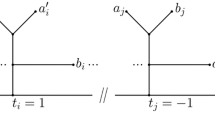Abstract
Agglomeration and addition are the two main algorithmic schemes for constructing a tree distance from a dissimilarity matrix. The former scheme iteratively agglomerates pairs of leaves to form larger and larger clusters, while the latter proceeds by stepwise addition of objects to a growing tree. A third approach involves improving the global fitness of an initial tree by exchanging subtrees. This article suggests that the shape of inferred trees partly depends on the chosen algorithmic scheme: agglomeration tends to produce compact and bushy tree shapes, while addition and exchange have a preference for sparse and chain-like trees. This phenomenon is explained by the difference between the a priori probability distributions induced by each scheme. An illustration is provided with the Mitochondrial Eve data set (Vigilant et al. 1991), and the practical impacts are discussed.
Access this chapter
Tax calculation will be finalised at checkout
Purchases are for personal use only
Preview
Unable to display preview. Download preview PDF.
Similar content being viewed by others
References
BARTHéLEMY, J.P. and A. GUéNOCHE (1991): Trees and proximity representations. Wiley, Chichester.
BOCK, H.H. (1996): Probabilistic models in cluster analysis. Computational Statistics and Data Analysis, 23, 5–28.
BROWN, J.K.M. (1994): Probabilities of evolutionary trees. Systematic Biology, 43, 78–91.
DAY, W.H.E. (1987): Computational Complexity of Inferring Phylogenies from Dissimilarity Matrices. Bulletin of Mathematical Biology, 49, 461–467.
EDWARDS, A.W.F. (1970): Estimation of branch points of a branching diffusion process. J. of the Royal Statistical Society B, 32, 155–174.
ERDOS, P.L., M. STEEL, L.A. SZEKELY, and T.J. WARNOW (1999): A few logs suffice to build (almost) all trees: Part II. Theoretical Computer Science, 221, 77–118
FARRIS, J.S. (1970): Methods for computing Wagner trees, Systematic Zoology, 34, 21–34.
FELSENSTEIN, J. (1993): Phylip (phylogeny inference package), version 3.5c, distributed by the author.
FELSENSTEIN, J. (1997): An alternating least-squares approach to inferring phylogenies from pairwise distances. Systematic Biology, 46, 101–111.
FLOREK, K., J. LUKASZEWICZ, J. PERKAL, H. STEINHAUS, and S. ZURBRZYCKI (1951): Sur la liaison et la division des points dun ensemble fini. Colloquium Mathematicum, 2, 282–285.
GASCUEL, O. (1997a): BIONJ: an improved version of the NJ algorithm based on a simple model of sequence data. Molecular Biology and Evolution, 14, 685–695.
GUénoche, A. and P. PRéa (1998): Counting and selecting at random phylogenetic topologies to compare reconstruction methods. Proc. of the Conf. of the International Federation of the Classifications Societies (IFCS’98), short papers volume, 242–245.
HARDING, E.F. (1971): The probabilities of rooted-tree shapes generated by random bifurcation. Advances in Applied Probabilities, 3, 44–77.
MCKENZIE, A. and M. STEEL (2000): Distributions of cherries for two models of trees. Mathematical Biosciences, 164, 81–92.
MOOERS, A. and S.B. HEARD (1997): Inferring evolutionary process from phylogenetic tree shape. The Quarterly Review of Biology, 72, 31–54.
PAGE, R.D.M. (1991): Random dendograms and null hypothesis in cladistic biogeography. Systematic Zoology, 40, 54–62.
RZHETSKY, A. and M. NEI. (1993): Theoretical Foundation of the Minimum-Evolution Method of Phylogenetic Inference. Molecular Biology and Evolution, 10, 1073–1095.
SAITOU, N. (1988): Property and efficiency of the maximum likelihood method for molecular phylogeny. Journal of Molecular Evolution, 27, 261–273.
SAITOU, N. and M. NEI. (1987): The neighbor-joining method: a new method for reconstruction of phylogenetic trees. Molecular Biology and Evolution, 4, 406–425.
Sattath, S. and A. TVERSKY (1977): Additive similarity trees. Psychometrika, 42, 319–345.
SORENSEN, T. (1948): A method of establishing groups of equal amplitude in plant sociology based on similarity of species content and its application to analyses of the vegetation on Danish commons. Biologiske Skrifter, 5, 1–34.
SWOFFORD, D.L., G.J. OLSEN, P.J. WADDELL, and D.M. HILLIS. (1996): Phylogenetic Inference. In D.M. Hillis, C. Moritz and B.K. Mable (eds.): Molecular Systematics, Sinauer, Sunderland (MA), 402–514.
VIGILANT, L., M. STONEKING, H. HARPENDING, K. HAWKES, and A.C. WILSON (1991): African populations and the evolution of human mitochondrial DNA. Science, 253, 1503–1507.
YULE, G.U. (1924): A mathematical theory of evolution based on the conclusions of Dr. J.C. Willis. F.R.S. PTRS B, 213, 21–87.
Author information
Authors and Affiliations
Editor information
Editors and Affiliations
Rights and permissions
Copyright information
© 2000 Springer-Verlag Berlin · Heidelberg
About this chapter
Cite this chapter
Gascuel, O. (2000). Evidence for a Relationship Between Algorithmic Scheme and Shape of Inferred Trees. In: Gaul, W., Opitz, O., Schader, M. (eds) Data Analysis. Studies in Classification, Data Analysis, and Knowledge Organization. Springer, Berlin, Heidelberg. https://doi.org/10.1007/978-3-642-58250-9_13
Download citation
DOI: https://doi.org/10.1007/978-3-642-58250-9_13
Publisher Name: Springer, Berlin, Heidelberg
Print ISBN: 978-3-540-67731-4
Online ISBN: 978-3-642-58250-9
eBook Packages: Springer Book Archive




